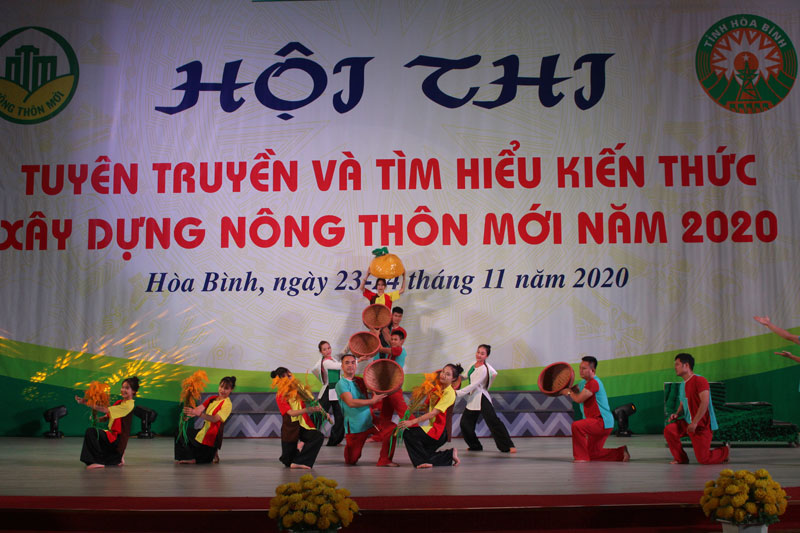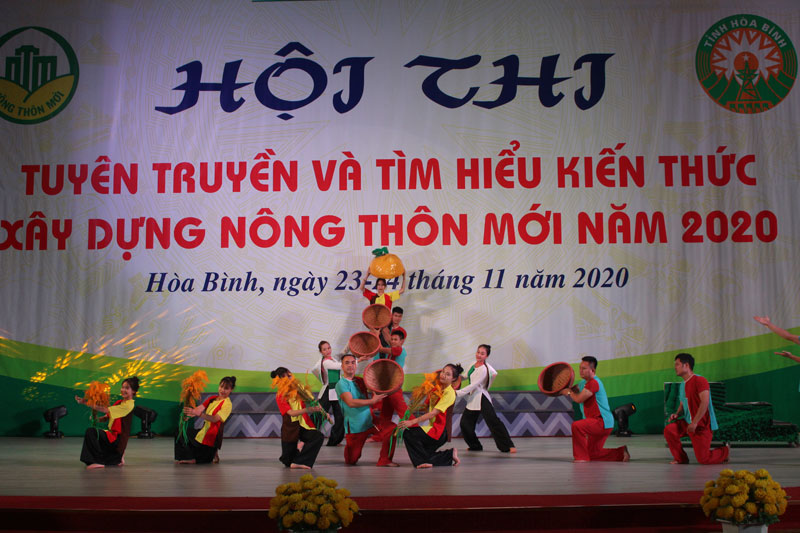
(HBO) - On November 24, the Department of Culture, Sports and Tourism coordinated with the Department of Agriculture and Rural Development to hold a summary of the contest to propagate and learn knowledge of building a new countryside in Hoa Binh province in 2020.
 The propaganda performances at the Contest.
The propaganda performances at the Contest.
The contest to propagate and learn
knowledge of the provincial new rural construction took place in two days from
November 23th to 24th with the participation of nearly 200 actors, propagators
and artisans of 8 propaganda teams from the districts and the city. The teams
went through the following competitions: decorating the propaganda vehicles,
demonstrating the display of agricultural products and new rural areas, the
greeting exam, the knowledge and arts exam. The topics of the contest focused
on learning knowledge about building new rural areas, rural stories, the
propaganda about the national target program to build new rural areas. The
teams showed the basic understanding and knowledge about the national target
program to build new rural areas, the methods and experience in the propaganda
for officials and people so that they could understand and participate in
building new rural areas through the competitions.
According to the Organizing Committee, all
of the teams have invested in expertise, bringing the quality programs and
performances to the contest, leaving a good impression on the viewers about the
propaganda content. In particular, the programs and performances have closely
followed the topics and the requirements of the Organizing Committee, and have
shown quite fully the results of implementing the movement of building new
rural areas in their localities.
At the end of the contest, the Organizing
Committee awarded 6 A prizes, 25 B prizes, 24 C prizes and 6 consolation prizes
to the participating units. In the end, for the whole delegation award, the
Organizing Committee awarded 2 A prizes to the Hoa Binh city and Lac Son
district, 3 prizes B to Cao Phong, Luong Son, Lac Thuy districts and 3 prizes C
to Tan Lac, Yen Thuy, Da Bac districts.
With an increasingly vibrant and widespread emulation movement aimed at building cultured residential areas and cultured families, Yen Thuy District has been making steady progress toward improving both the material and spiritual well-being of its people, while fostering a civilized, prosperous, beautiful, and progressive community.
Once lacking recreational spaces and community facilities, Residential Group 2 in Quynh Lam Ward (Hoa Binh City) has recently received attention for the construction of a new, spacious, and fully equipped cultural house. The project followed the model of state support combined with public contributions in both labor and funding.
The "All people unite to build cultural life" movement, which has been effectively integrated with Kim Boi district’s socio-economic development goals, is fostering a lively spirit of emulation across local residential areas, hamlets, villages, public agencies, and enterprises. In addition, through the initiative, traditional cultural values are being preserved and promoted, while community solidarity and mutual support in poverty reduction and economic development are being strengthened.
A working delegation of the Hoa Binh provincial People’s Committee led by its Permanent Vice Chairman Nguyen Van Toan on June 11 inspected the progress of a project to build the Mo Muong Cultural Heritage Conservation Space linked to tourism services in Hop Phong commune, Cao Phong district.
Born and growing in the heroic land of Muong Dong, Dinh Thi Kieu Dung, a resident in Bo town of Kim Boi district, in her childhood was nurtured by the sweet lullabies of her grandmother and mother. These melodies deeply imprinted on her soul, becoming an inseparable part of her love for her ethnic group's culture. For over 20 years, this love for her hometown has driven Dung to research, collect, and pass down the cultural values of the Muong people to future generations.
In the final days of May, the Ethnic Art Troupe of Hoa Binh Province organized performances to serve the people in remote, mountainous, and particularly disadvantaged areas within the province. These were not just ordinary artistic shows, but they were the meaningful journeys aimed at spreading cultural values, enhancing the spiritual life of the people and contributing to the preservation of ethnic minority cultural identities.



 The propaganda performances at the Contest.
The propaganda performances at the Contest.